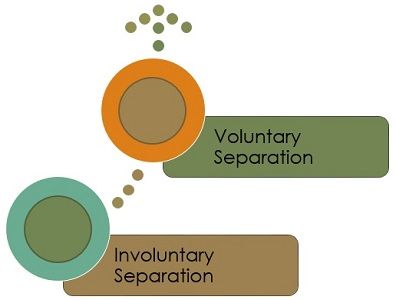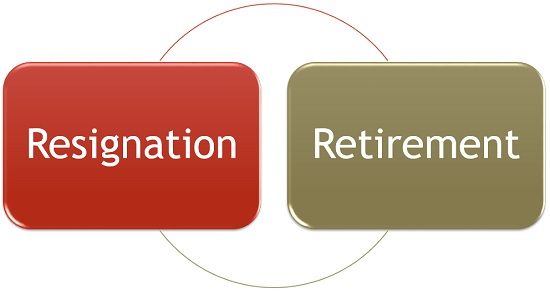Definition: Employee Separation refers to the process of termination of the relationship between employee and employer, which takes place when the employee leaves the company.
Types of Employee Separation
On the basis of initiation for separation, there are two types of employee separation:
Voluntary Separation
The form of separation when the employee himself/herself initiates it, i.e. the employee takes the decision to bring to an end his/her relationship with the employer. It includes:
- Resignation: When the level of dissatisfaction is high in the employee from his or her current job, or he/she finds some better opportunities for growth and promotion in some other job, then the individual decides to quit the company by resigning.The reasons for dissatisfaction in the employee may be the job itself or some other external factors including health, compensation, policies, development opportunities and spouse relocation, and so forth.
- Retirement: Retirement of an employee is a stage when the employee reaches superannuation age where he/she has to leave the organisation. It brings an end to their career. The age of retirement varies from organisation to organisation.On the retirement of the individual several benefits or privileges are provided to him/her called as retirement benefits, which includes pension, gratuity, provident fund, etc.
Involuntary Separation
Another form of separation is involuntary separation, wherein it is the employer who decides to initiate separation. This is due to the following factors:
- The lean period is encountered by the organization, due to which it is not possible for the organization to maintain the existing workforce.
- The employee is not suitable for the job.
- The deviant behaviour is shown by the employee which affects the overall environment of the company.
Types of involuntary separation:
- Discharge: When the employer firm recognizes that keeping an employee is no more profitable to the company, it is called as Discharge.
- Lay-off: Lay-off is a non-permanent separation in which the employer fails or refuses to provide employment to the worker. It is a period which exists for a specified term, and on the expiry of this period, the employees who are laid-off are recalled by the employer to continue their duty.The employees are laid-off either on the basis of merit or seniority.
- Dismissal: One of the crucial step taken by the employer, resulting in termination of the employee from his/her duties, is dismissal. Before dismissing an employee, first of all, the warning is given, thereafter necessary actions are taken if the employee has not taken the warning seriously.The causes of dismissal are serious misconduct, offensive behaviour, excessive absenteeism or idle time, theft of the property of the company.
- Retrenchment: Retrenchment is also a severe condition whereby several employees are separated by the employer due to many reasons such as the closure of the division or unit in which they work, or workers are replaced by machines.
- Voluntary Retirement: It is a scheme in which the organization offers its existing employee to take retirement even when they have not reached the age of superannuation, it is called as voluntary retirement scheme (VRS) or otherwise known as Golden Hand Shake Plan.This method leads to a reduction in the staff strength, specifically the unproductive one.
- Rightsizing: Rightsizing refers to the modifications in the key work processes, which encompasses part-time works, sabbaticals, pay cuts, reduced work weeks, etc.
Employee separation has both positive and negative impact on the organization. Its positive aspect is that it saves wages and salaries and the new employees may bring new ideas and expertise and work energetically.
On the negative end, it may demoralize employees, or the employees probably badmouth about the organization. Further, it may also add to the cost, in the recruitment and training of the new entrants.




Leave a Reply